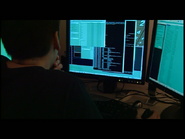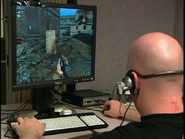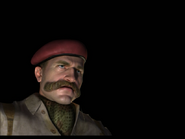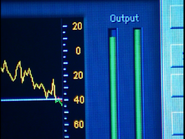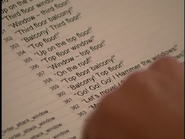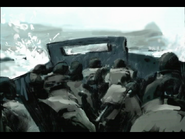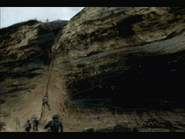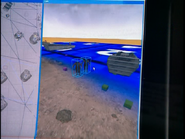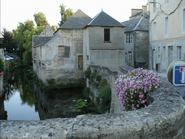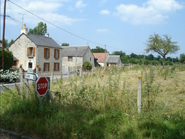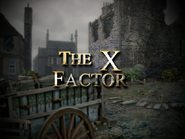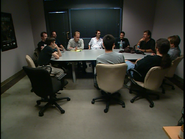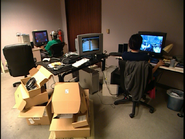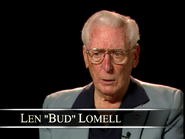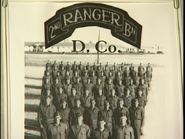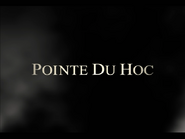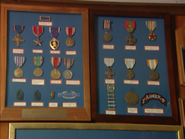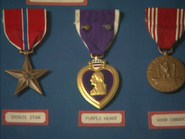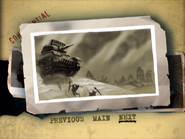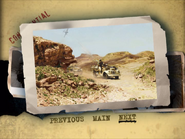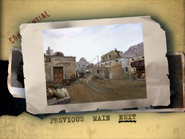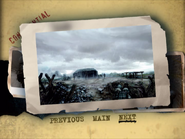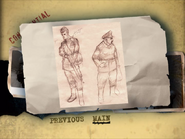The Call of Duty 2 Special Edition Bonus DVD is an exclusive extra with behind-the-scenes content included with the 2006 Platinum Hits edition of the Xbox 360 version of Call of Duty 2 whose covers are marked with a large red dot reading "includes bonus DVD". It comes in a paper sleeve.
The DVD includes four videos and one interactive image gallery, all immediately accessable through the main menu. The first video is a six-minute documentary titled The Making of Call of Duty 2, the second is a four-minute interview video with real-world World War II veteran Leonard Lomell (whom portions of the American campaign in Call of Duty 2 were inspired by), and the last two videos are developer commentaries of game testers playing the levels "The End of the Beginning" and "Repairing the Wire".
Though the Platinum Hits edition of Call of Duty 2 is labeled as a special edition on its cover with the logo side of the DVD bearing the same title, the main menu bears the title "Call of Duty 2: Collector's Edition".
Behind the Scenes with Infinity Ward: The Making of Call of Duty 2[]
The Making of Call of Duty 2 is a short 6:49 documentary following the development process of Call of Duty 2 from the success of the original Call of Duty to the late stages of development, as told by Jason West and Grant Collier, both senior members of Infinity Ward who have since left the company following the Jason West, et al. vs. Activision Publishing, Inc. lawsuit against their publisher. It contains clips of developers working on the game, members of Infinity Ward occasionally in meetings, actors from the 2001 mini-series Band of Brothers lending their voice for the game as well as mid-development game footage and concept art not seen in the concept art section of the DVD.
Transcription[]
Jason West, Chief Technology Officer: Following up on Call of Duty 1 was a big challenge—we weren't sure which direction we wanted to take it.
Narrator: Come behind the scenes with Infinity Ward as they face the challenges and triumphs of creating Call of Duty 2.
The Making of Call of Duty 2
Grant Collier, President: When we first started out, Infinity Ward was 22 members of the Medal of Honor: Allied Assault team that worked out in Tulsa, Oklahoma.
Narrator: In 2002, Infinity Ward began work on the original Call of Duty.
Collier: We knew we had money, we were just--this is money, we put money on the table, you need to play this. The news of that prototype just went through Activision like wildfire.
Narrator: The game quickly evolved into a groundbreaking departure for World War II first-person shooters, earning it over 80 Game of the Year awards.
Collier: That set, like, a pretty high bar for Call of Duty 2. What are we going to do differently? How are we going to top that?
West: Well one of the things about Call of Duty 1 was that some people thought it was a little too linear, so we wanted to open up the gameplay. This required reinventing the AI completely because we didn't know which direction the player would be approaching the direction from. So you can't just pre-plan a course and do a series of scripted events, you need to really algorithmically figure out how to respond to what the player is going to do from any angle.
Collier: So we had to create very autonomous AI—AI that could retreat from his position, can set up ambushes, can try to flank the player—they've got vision cones, hearing radiuses; they're just more self-aware than they were in Call of Duty 1, and that was a huge--a huge change, a huge overall, and it caused us to basically throw out the Call of Duty 1 engine and create our own proprietary technology.
West: There were a lot of challenges that we encountered. Basically, we just made the level we wanted to make and played the game and watched where the AI fell down, then had to go to the drawing board and try to figure out how to--how to solve these problems. So we did that for a year and a half, basically—just constantly working on the AI, improving it, tweaking it, tuning it until we got to the point where we liked it.
Breaking New Ground with Battle Chatter
John Frank Hughes: Move in!
Unknown voice actor: Hassle! Come on, let's go!
West: So one of the things that came out of the non-linear gameplay, mixed with all-new AI, was how do we make this AI even more important to the player and make him appreciate his friendly troops more, and basically what came out of that was this Battle Chatter system where the AI understand the field of battle, they call out enemy troops, they call out positions--
MacGregor: Flank that machine gun from the right!
Collier: Now, we the AI so autonomous that they knew where they were, wherever they were on the map—any location; if they were on a second floor of a building, if they were behind a wall--
British soldier: Krauts on the eighty-eight!
Collier: They had to know exactly where their surroundings were. Your AI is very self-aware and they're telling you what their current situation is, what the enemy is doing--
Russian soldier: It's the Germans! Up on the second floor!
Collier: --and really brings that player in into being part of that squad, and for any of our fans that speak German, you can hear that we brought that same contact-sensitive Battle Chatter system over to the Germans.
German soldier: In deckung!
Subtitles: Take over!
West: We came up with true military terms—how they actually communicate with each other—as well as look at all of the levels in the game and the geometry, and basically gave it all names. Then we had to record over 20,000 lines of dialogue.
James Madio: Machine gun coming up!
West: Put that in code, y'know, so the AI knows about it. One of the big challenges was striking just the right sweet spot. We didn't want it happening too much because then it's just noise and it fades into the background, and if it happens not enough it's not as useful to the player as it could be.
The Fog of War
Collier: We have two military advisers that were really instrumental with developing Call of Duty. We asked them, 'what--what were the things that were missing from Call of Duty 1 that you see on the battlefield, that you experienced everyday?' And they said, 'well, there's portable concealment--'
Russian soldier: Wait! Wait for the smoke to fill! Alright, go! Let's go!
Collier: Portable concealment, AKA smoke, has been used in warfare for over 150 years, and there's none of it in Call of Duty 1, so we created this really robust particle system and it just adds a real level of immersion that we didn't have before.
Recreating Du Hoc
West: We have a lot of great level designers who do a lot of research and are inspired by real events, so on the Du Hoc level, for example, y'know, the Rangers did actually scale the cliff face, and the guns had actually been moved, and they did actually have to go find the guns.
Collier: We storyboard out this stuff, and it was soldiers start out on the Higgins Boat on the way in, soldiers are on the beaches, soldiers scale the cliffs—it was a lot more complicated when we implemented it than what we saw just from the storyboards. That whole level took a massive effort from a large group of people for a few months before we had the--the E3 trade show and, y'know, two weeks in, you're just like 'I don't see it, y'know', three weeks in, 'don't see it', four weeks in, 'there's something going on here', five weeks in, 'wow, we got some magic'.
Narrator: Keeping up their high standards for authenticity, the team did extensive research, including sending design teams to North Africa and France.
Collier: We had an artist and a game designer to check out what a real North African village looks like. We also sent, um, a few artists to Normandy to check out French villages. There's a big difference between how Americans perceive a French village and how they are really are laid out, and they really caused a big redesign for a lot of stuff.
The X Factor
Collier: Probably the biggest challenge we had, I think maybe a month into development of that, Microsoft came to Activision and said, 'we want Call of Duty to be a launch title exclusive to the Xbox 360.' We told them 'it's not going to be a problem; we're going to knock it out of the park.' Then we got back to our office and we're like, 'okay, we have to somehow plan to use a bunch of art techniques that haven't been invented yet, so let's design those in. We need to design the game for hardware that doesn't exist. We need to schedule out workflows for people we haven't even hired yet.' I think that was just a real kind of amazing thing how, kind of, you can visualize how the stuff is going to work out, how you're gonna hire these people, how you're going to work on this hardware and just through sheer force of will and people working late hours and having a lot of passion, how it all really just kind of came together.
Gallery[]
Rangers Lead the Way: Historical Account of Pointe Du Hoc[]
The second video on the DVD is a 4:51 interview with World War II veteran Leonard "Bud" Lomell titled Rangers Lead the Way as he recalls his actions on D-Day as company First Sergeant of D Company of the 2nd Ranger Battalion, landing at Pointe Du Hoc. His account and actions inspired the level "The Battle of Pointe du Hoc", where his role was filled by Sgt. Randall and Cpl. Bill Taylor.
The end of the video states that Lomell lives with his wife in New Jersey. Though this was true when the DVD was released in 2006, Lomell passed away on March 1, 2011.
Transcription[]
Len "Bud" Lomell: My name is Leonard G. Lomell. I was first sergeant of D Company, Second Ranger Battalion, United States Army in World War II. I entered the service in June of 1942 and I was discharged in 1945.
Rangers Lead the Way
Lomell: Rangers are special to me because they know we accept no excuses. They're always truthful, they're always hard working, their main objective all the time is to accomplish the mission.
D-Day, Normandy.
D, E, and F Companies of the 2nd Ranger Battalion were assigned to take out six 155mm guns atop the 100-foot cliffs of Pointe Du Hoc.
Failure to disable this artillery would seriously jeopardize the Omaha and Utah Beach landings.
Pointe Du Hoc
Lomell: My first combat, as such, was D-Day. Lots of things happened when we landed.
American soldier: Incoming! Get down!
Lomell: I was the first man wounded in my company, shot through the right side in the flesh, which didn't keep me down—it knocked me down and it burned like the dickens, but we had to put down that fight on the beach and run to the ropes. We had to find a rope we could climb and jerk on it enough to have it satisfy yourself that it's dug in up there, hundreds of feet up, and we climb the ropes as quickly as we could, and never did they ever dream anybody would be crazy enough to climb those cliffs with that [inaudible].
American soldier: Go, go!
Lomell: We went on and we ran into the Germans, they bunched up and we had a firefight with them, and I just jumped from one crater to another crater whenever the timing was right. The first part of the mission, of course, was finding guns and destroying the guns. Well, we got over there and there wasn't anything in the three gun emplacements that were assigned to my company—D Company.
Braeburn: The guns are gone! They're not here!
Randall: What?
Braeburn: The guns - aren't - here! The Krauts must've moved 'em someplace else!
Randall: Well, hell! Keep moving! We're sitting ducks out here!
Lomell: We found a road heading inland. Went down, and it was a road between two hedgerows. We noticed that there was something heavy, like a wagon loaded with whatever, that had been over it, but it just as easily been the wheels of one of these one-five-five millimeter coastal artillery pieces. We didn't know, and no other choice—we weren't pulling off some brilliant act here of solving where the guns are. We just took the first bit of evidence and I ran down to the hedgerow ahead and there they were. When I went in, I said 'Jack, take your hedge spot there—there's a lot of foliage there—and you hide in that foliage, and you'—as I had seen, and he did too, about 75 to 100 men maybe 75 or 100 yards away. They never dreamed that there was two American soldiers near them. They didn't know the Rangers were that far. They didn't know the Rangers were coming, of course! And it was during those few minutes that I was able to at least set those thermite grenades, as they later became known as, on the traversing mechanism of the guns. Now, I think we had them out of action totally before 8:30 in the morning, which was tremendous because we prevented those ships from being sunk and the landing areas at all those beaches on Omaha Beach and west of Omaha Beach were within range—and Utah Beach—so that saved the guys on those beaches.
Not Heroes, Just Rangers
Lomell: We get sick and tired of the word 'hero' because we have so many friends that died, giving their life for America, and to me they'll always be our heroes, and that goes for the guys who didn't get decorated. There are many guys that didn't get the recognition that they deserve. We worked hard at being the best of the best, and we more than held our own. This executive officer—he was a general, a brigadier general—said 'alright, so you're Rangers! Well then, lead the way, Rangers!' and that became our motto ever after. It is to the present day: 'Rangers lead the way'—and we did!
Ranger Leonard G. Lomell was awarded the Distinguished Service Cross, the Bronze Star, the Victory Medal and the Purple Heart with [oak leaf] cluster for his actions during World War II.
He currently resides with his wife in New Jersey.
Gallery[]
Mission Walk-Throughs with Developer Commentary[]
The final video portion of the DVD features the commentary of Infinity Ward employees Jason West, chief technology officer; Steve Fukuda, lead designer; Vince Zampella, chief creative officer; Mackey McCandlish, designer; and Zied Rieke, senior lead ddesigner as they watch footage of game testers play the levels "The End of the Beginning" and "Reparing the Wire", describing aspects of the game and its engine they worked on that can be seen in the level and how the level changed as the game's development progressed.
Gallery[]
The Art of Call of Duty 2: Concept and Production Art Gallery[]
The final section of the DVD is an interactive gallery of concept art and sketches of characters and locations in Call of Duty 2.








